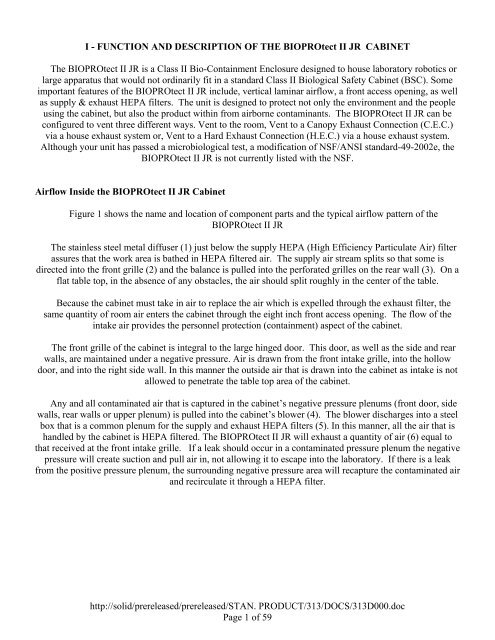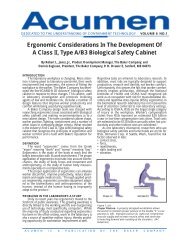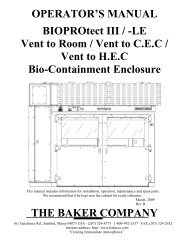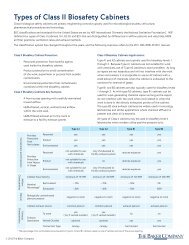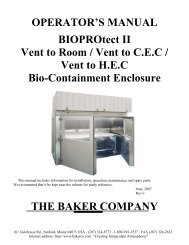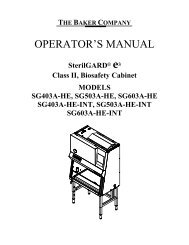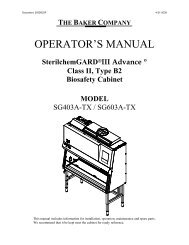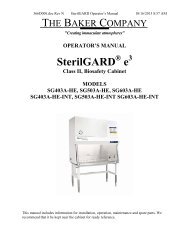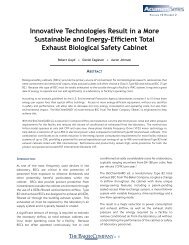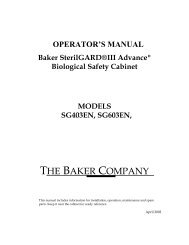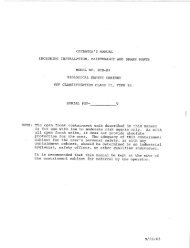OPERATOR'S MANUAL BIOPROtect II JR Vent to ... - Baker Company
OPERATOR'S MANUAL BIOPROtect II JR Vent to ... - Baker Company
OPERATOR'S MANUAL BIOPROtect II JR Vent to ... - Baker Company
Create successful ePaper yourself
Turn your PDF publications into a flip-book with our unique Google optimized e-Paper software.
I - FUNCTION AND DESCRIPTION OF THE <strong>BIOPROtect</strong> <strong>II</strong> <strong>JR</strong> CABINET<br />
The <strong>BIOPROtect</strong> <strong>II</strong> <strong>JR</strong> is a Class <strong>II</strong> Bio-Containment Enclosure designed <strong>to</strong> house labora<strong>to</strong>ry robotics or<br />
large apparatus that would not ordinarily fit in a standard Class <strong>II</strong> Biological Safety Cabinet (BSC). Some<br />
important features of the <strong>BIOPROtect</strong> <strong>II</strong> <strong>JR</strong> include, vertical laminar airflow, a front access opening, as well<br />
as supply & exhaust HEPA filters. The unit is designed <strong>to</strong> protect not only the environment and the people<br />
using the cabinet, but also the product within from airborne contaminants. The <strong>BIOPROtect</strong> <strong>II</strong> <strong>JR</strong> can be<br />
configured <strong>to</strong> vent three different ways. <strong>Vent</strong> <strong>to</strong> the room, <strong>Vent</strong> <strong>to</strong> a Canopy Exhaust Connection (C.E.C.)<br />
via a house exhaust system or, <strong>Vent</strong> <strong>to</strong> a Hard Exhaust Connection (H.E.C.) via a house exhaust system.<br />
Although your unit has passed a microbiological test, a modification of NSF/ANSI standard-49-2002e, the<br />
<strong>BIOPROtect</strong> <strong>II</strong> <strong>JR</strong> is not currently listed with the NSF.<br />
Airflow Inside the <strong>BIOPROtect</strong> <strong>II</strong> <strong>JR</strong> Cabinet<br />
Figure 1 shows the name and location of component parts and the typical airflow pattern of the<br />
<strong>BIOPROtect</strong> <strong>II</strong> <strong>JR</strong><br />
The stainless steel metal diffuser (1) just below the supply HEPA (High Efficiency Particulate Air) filter<br />
assures that the work area is bathed in HEPA filtered air. The supply air stream splits so that some is<br />
directed in<strong>to</strong> the front grille (2) and the balance is pulled in<strong>to</strong> the perforated grilles on the rear wall (3). On a<br />
flat table <strong>to</strong>p, in the absence of any obstacles, the air should split roughly in the center of the table.<br />
Because the cabinet must take in air <strong>to</strong> replace the air which is expelled through the exhaust filter, the<br />
same quantity of room air enters the cabinet through the eight inch front access opening. The flow of the<br />
intake air provides the personnel protection (containment) aspect of the cabinet.<br />
The front grille of the cabinet is integral <strong>to</strong> the large hinged door. This door, as well as the side and rear<br />
walls, are maintained under a negative pressure. Air is drawn from the front intake grille, in<strong>to</strong> the hollow<br />
door, and in<strong>to</strong> the right side wall. In this manner the outside air that is drawn in<strong>to</strong> the cabinet as intake is not<br />
allowed <strong>to</strong> penetrate the table <strong>to</strong>p area of the cabinet.<br />
Any and all contaminated air that is captured in the cabinet’s negative pressure plenums (front door, side<br />
walls, rear walls or upper plenum) is pulled in<strong>to</strong> the cabinet’s blower (4). The blower discharges in<strong>to</strong> a steel<br />
box that is a common plenum for the supply and exhaust HEPA filters (5). In this manner, all the air that is<br />
handled by the cabinet is HEPA filtered. The <strong>BIOPROtect</strong> <strong>II</strong> <strong>JR</strong> will exhaust a quantity of air (6) equal <strong>to</strong><br />
that received at the front intake grille. If a leak should occur in a contaminated pressure plenum the negative<br />
pressure will create suction and pull air in, not allowing it <strong>to</strong> escape in<strong>to</strong> the labora<strong>to</strong>ry. If there is a leak<br />
from the positive pressure plenum, the surrounding negative pressure area will recapture the contaminated air<br />
and recirculate it through a HEPA filter.<br />
http://solid/prereleased/prereleased/STAN. PRODUCT/313/DOCS/313D000.doc<br />
Page 1 of 59


